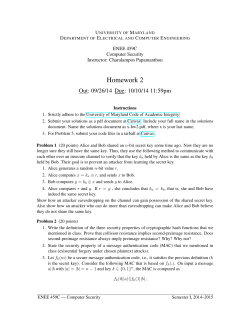
Cipher Type Detection
Cipher Type Detection ∗ † Malte Nuhn and Kevin Knight ∗ Human Language Technology and Pattern Recognition, RWTH Aachen University † Information Sciences Institute, University of Southern California Overview Example Cipher Manual analysis and decryption of enciphered documents is a tedious and error prone work. Often—even after spending large amounts of time on a particular cipher—no decipherment is found. In general the key of an encipherment method can consist of more than just a codeword: Automating the decryption of various types of ciphers makes it possible to sift through the large number of encrypted messages found in libraries and archives, and to focus human effort only on a small but potentially interesting subset of them. Type: CMBIFID Plaintext: WOMEN NSFOO TBALL ISGAI NINGI NPOPU LARIT YANDT HETOU RNAME Key: We train a classifier that is able to predict which encipherment method has been used to generate a given ciphertext. LEFTKEY=’IACERATIONS’, RIGHTKEY=’KNORKOPPING’ PERIOD=3, LROUTE=1, RROUTE=1, USE6X6=0 Problem Definition Ciphertext: WTQNG GEEBQ BPNQP VANEN KDAOD GAHQS PKNVI PTAAP DGMGR PCSGN Each encipherment method transforms a given plaintext into a ciphertext using a given key. For unknown ciphers, we are interested in the original plaintext. 60 40 30 Lehrstuhl fur ¨ Informatik 6 – Computer Science Department – RWTH Aachen University – Aachen, Germany www: http://www-i6.informatik.rwth-aachen.de N IC PH IC BD I C D D SS TD M PI C SE R P R EP AM SC VA R X PT I D R R M O N D 10 BL 20 I Repetition Feature (REP): How often does the ciphertext contain symbols that are repeated exactly n times in a row? Add features for repetitions of length 2 ≤ n ≤ 5. Amsco Feature (AMSC): Apply all possible permutation patterns used in the AMSCO cipher, and measure perplexity of the resulting text in a bigram LM. Variant Feature (VAR): Calculate individual unigram count statistics for specific parts of the cipher text. Compare these frequency profiles against the frequency profile of english. Accuracy (%) On top of 55 previously published features for cipher type detection, we add three newly developed sets of features. 50 LD Features bion SVM 10k SVM100k VW 100k VW 1M M IC M KA D IC ED I LR RO D We train an SVM using the libSVM toolkit. This is feasible for up to 100k training examples. In order to use more training data, we use Vowpal Wabbit to train a linear classifier that is trained with up to 1M training examples. quagmire3 I quagmire4 I ragbaby I randomdigit I randomtext I redefence I runningkey I seriatedpfair I swagman I tridigital I trifid I trisquare I trisquare hr I two square I two sq. spiral I vigautokey I We identified the best classifier on a held-out set of 1000 ciphers, i.e. 20 ciphers for each cipher type. Here our three new features improve the VW-1M classifier from 50.9% accuracy to 56.0% accuracy, and the VW-100k classifier from 48.9% to 54.6%. The figure below, shows the results of our method on the completely independently created ACA test set: IC Classifiers mnmedinome I morbit I myszkowski I nicodemus I nihilistsub I patristocrat I period 7 vig. I periodic gromark I phillips I plaintext I playfair I pollux I porta I portax I progkey beaufort I progressivekey I quagmire2 I Results G We take a machine learning type key plaintext approach which is based on the observation that we can encipher generate an infinite amount of training data. Based upon ciphertext a large English corpus, we first choose possible plaintext messages. Then, for classifier training each encipherment method, we choose a random key and encipher each of the plaintext messages using the encipherment method and key. We then train a classifier on this data. We do this for 50 cipher types defined by the American Cryptogram Association (ACA). VI Machine Learning Approach N Given an unknown ciphertext, predict what kind of encryption method was used to generate it. 6x6bifid I 6x6playfair I amsco I bazeries I beaufort I bifid6 I bifid7 I cmbifid I columnar I digrafid I dbl chckrbrd I four square I fracmorse I grandpre I gromark I gronsfeld I homophonic I LE In this paper, we focus on identifying the encipherment method: Supported Cipher Types H AS Obtaining the plaintext from an enciphered message is difficult. We assume that the decipherment of a message can be separated into three steps: finding the encipherment method, finding the key, and the actual decoding. Features e-mail: ∗<surname>@cs.rwth-aachen.de, † <surname>@isi.edu
© Copyright 2025





















